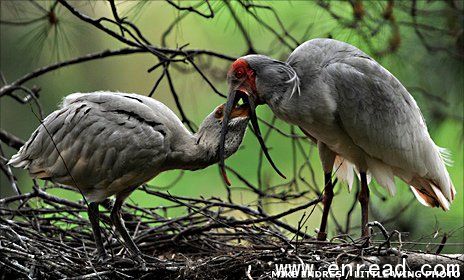One fifth of animal and plant species are under the threat of extinction, a global conservation study has warned.
一项全球环境保护研究警告,五分之一的动物和植物处于灭绝的边缘。

Some 13% of birds qualify for inclusion on the Red List Scientists who compiled the Red List of Threatened Species say the proportion of species facing wipeout is rising.
But they say intensive conservation work has already pulled some species back from the brink of oblivion(遗忘,湮没) .
The report is being launched at the UN Biodiversity Summit in Japan, where governments are discussing how to better protect the natural world.
Launched at the UN Convention on Biological Diversity (CBD) meeting, the report says that amphibians(两栖动物) remain the most threatened category of animals, with 41% of species at risk, while only 13% of birds qualify for Red-Listing.
The highest losses were seen in Southeast Asia, where loss of habitat as forests are cleared for agriculture, including biofuel crops, is fastest.
"The 'backbone' of biodiversity is being eroded," said the eminent(杰出的,明显的) ecologist, Professor Edward O Wilson of Harvard University.
"One small step up the Red List is one giant leap forward towards extinction. This is just a small window on the global losses currently taking place."
However, the scientists behind the assessment - who publish their findings formally in the journal Science - say there is new evidence this time that conservation projects are having a noticeable global impact.
"Really focused conservation efforts work when we do them - many island birds are recovering, lots of examples like this," said Simon Stuart, chair of the Species Survival Commission with the International Union for the Conservation of Nature (IUCN).
"We can show for sure that when we focus conservation efforts and really address the threats and put enough money into it, then you see positive results."
Species that have benefited from such action include three bred in captivity and returned to the wild - the California condor(秃鹫,秃鹰) and black-footed ferret(雪貂) of the US, and Przewalski's horse in Mongolia.
The ban on commercial whaling has led to such a swiftly increasing population of humpback whales(座头鲸) that they have come off the Red List entirely.
Meanwhile, a parallel study, also published in Science, asks where trends of increased risk, but also increased conservation effort, will lead the natural world in future.
Researchers analysed a range of scientific studies and global assessments. Although projections varied, all found that fundamental changes are needed in order to avoid declining populations across many types of plant and animal species.

